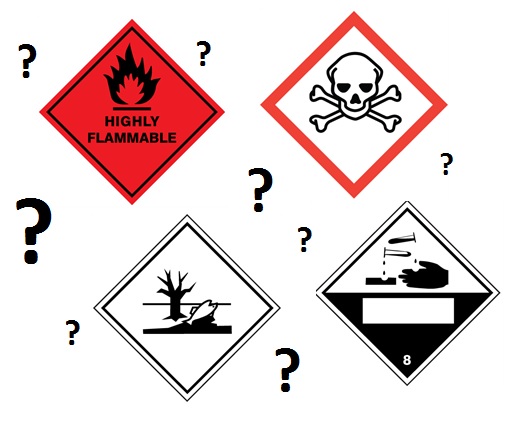
If you are around hazardous materials, it’s important that everything is correctly labelled to ensure everyone’s safety. Luckily, here at Label Source, we have a huge selection of products that enable you to correctly label any chemical.
There are plenty of different reasons why chemicals need labelling, so here are some of the products we offer. We’ll also cover why hazardous chemical labels are important, as well as the laws you need to know.
Types of Chemical Labels
Diamond Hazard Warning Labels
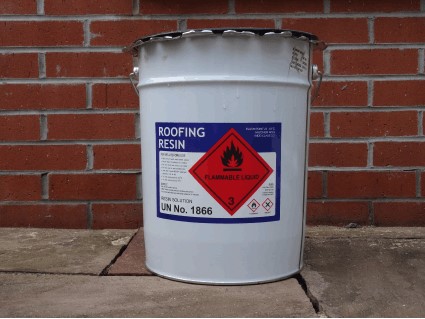
This chemical hazard label is a clear warning sign, which is both common and recognisable. These labels can be used for a variety of different chemicals including: corrosive liquids, flammable materials, toxic substances, etc.
Each diamond hazard warning label has its own recognisable safety symbol and colour code, so you can be sure you have the right warning for the right chemical. Although we supply a diverse collection, we also offer blank diamond labels that allow you to write on them for a specific warning.
Discover our range diamond hazard warning labels today.
Chemical Spill Kit Label
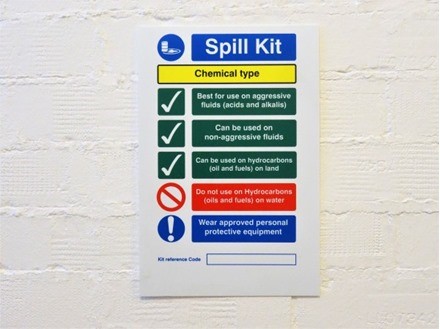
This spill control sign explains what to do in the event of a chemical spill. This sign instructs what trained staff (with protective equipment) should do in the event of aggressive and non-aggressive liquids spillage.
Chemical spill kit labels help to keep staff calm and organised, ensuring spills don’t cause excess damage, especially if they’re corrosive, flammable or toxic.
GHS Chemical Labels
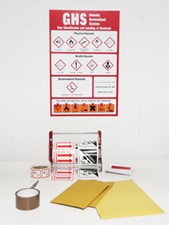
The international standard for chemical labelling is the Globally Harmonised System (GHS). The GHS ensures that all dangerous chemicals are labelled in the same way over the world, so it is important that any chemical labels you have are compliant with GHS regulations.
Our comprehensive range of GHS labels will ensure you clearly identify any hazardous materials.
UN Labels
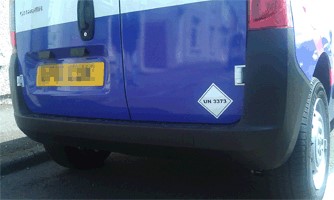
If there are any hazardous materials being transported by a vehicle, some additional information may be needed, which is why we supply products to deal with this.
Identifying what kinds of hazardous goods are being transported allows emergency services to act accordingly in the event of an accident.
You can find out more on UN labels in our in-depth blog post: How UN Labels Protect Goods During Transportation.
Why Are Labels For Chemicals Important?

Chemical labels ensure hazardous substances don’t harm people. It’s a basic concept, but the solutions to safeguard people usually aren’t – it requires significant time and effort to put labelling regulation in place.
Clear, logical classification and labelling ensures chemicals that could be hazardous to people and the environment don't spill out of control. UK regulations state that all businesses must follow CLP regulations. In effect, this means:
- Use appropriate classification and labelling standards on all hazardous items.
- Carry out chemical risk assessments to ascertain risk. We've covered the role risk assessments have in controlling danger here: Risk Assessment Kits: Prevent Accidents & Injuries in Your Workplace.
- Ensure all labelling and packaging is regularly reviewed so they fall in line with the latest regulations.
- Hazard labelling in the UK must be in English.
What are the CLP Regulations?

CLP stands for “Classification, Labelling and Packaging”. These regulations play an important role in chemical labelling.
CLP regulation requires manufacturers, importers and/or downstream users of substances to classify, label and package hazardous substances properly.
Classification and labelling are essential cornerstones of CLP. It is a legally binding agreement between major members states, of which the UK is one. Without CLP regulation, it’s difficult to ascertain how dangerous a chemical is, how to store it, transport it and handle it.
CLP is always the first step in chemical safety.
The first part of CLP regulation is classification. The classification stage uses information such as toxicological data and studies to determine how dangerous a chemical is. Depending on the hazard’s danger, it is then classified and categorised.
The categorisation is based upon the tenants of the Globally Harmonised System (GHS), which governs the appearance of hazard labels. We’ve written about GHS labels previously, as well as what their categorisation means, in: GHS: What is a GHS Label and Why is it Used?
Outside of classification, CLP outlines packaging standards and labelling requirements. Oftentimes, CLP can be used as the basis to change legislation around chemicals and their management, too.
As a business owner, it’s important to know that chemical regulation isn’t just invented out of thin air – it’s done for a reason.
What Chemical Health and Safety Legislation Do I Need To Follow?

The handling of chemicals is governed by the Control of Substances Hazardous to Health (COSHH) 2002. This law governs the use of chemical substances and mixtures, as well as providing guidance on the correct labelling of chemicals.
Broadly, COSHH covers:
- How to find the exact dangers of hazardous chemicals.
- How to carry out a COSHH risk assessment.
- Establishing control measures.
- How to follow correct labelling of chemicals.
- The maintenance of chemical-related safety equipment.
- Educating staff.
- Planning emergency responses to hazards.
We have covered COSHH and its implications in a separate blog post: What are the COSHH Regulations?
Do I Need To Use Safety Data Sheets?

Separate from chemical labels are safety data sheets (SDS). Chemical products with hazardous substances all require SDS. In total, they list:
- Chemical or product dangers.
- Precautionary measures.
- How to deal with emergencies.
SDS is a requirement of Registration, Evaluation, Authorisation and restriction of Chemicals (REACH) regulations. All staff who handle the chemicals must be made aware of relevant SDSs before using them.
REACH regulations were set up by the European Union to safeguard human health when handling chemicals, particularly those which are flammable, corrosive or toxic. SDSs were a new addition, allowing for staff, suppliers and employers to better understand how to protect against chemical dangers.
Browse High-Quality Labels For Chemicals Today
We have a wide range of chemical labels in our collection that should match any of your requirements. For any advice on what label would best suit your needs call us on 0800 3761 693.